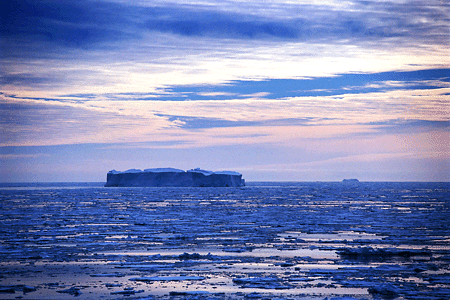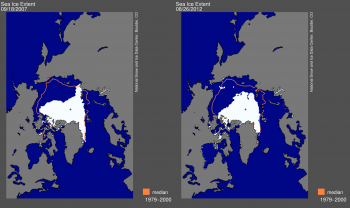New Record for Arctic Ice Melt
Monday, September 24th, 2012September 24, 2012
Arctic sea ice melted to unprecedented levels in September, smashing all previous records. The sea ice reached its yearly minimum size on September 16, 2012, according to scientists with the National Snow and Ice Data Center (NSIDC). At that time, the sea ice covered 1.32 million square miles (3.41 million square kilometers), an area 18 percent smaller than ice cover at the last previous record, which was set in 2007. The NSIDC, located in Boulder, Colorado, is affiliated with NASA, the National Oceanic and Atmospheric Administration, and the University of Colorado.
Each year, Arctic sea ice grows and shrinks in area with the changing seasons. The sea ice reaches its largest area in March. It shrinks through the spring and summer, reaching its smallest size in September. It then grows through the fall and winter. This year, the ice shrank by 4.57 million square miles (11.83 million square kilometers) between March and September. That is the largest loss ever recorded, exceeding every other year by nearly 400,000 square miles (1 million square kilometers). The 2012 record was 49 percent smaller than the long-term average from 1979 to 2000, an area nearly twice the size of Alaska. Arctic sea ice has deteriorated rapidly in recent years. In fact, all of the six lowest years for sea ice cover have occurred in the last six years.

Floating ice covers much of the Arctic Ocean’s surface. Most of the ice is sea ice (frozen seawater) that drifts with the currents. The rest is freshwater glacial ice, which breaks off from glaciers along the coasts of Arctic lands. Chunks of glacial ice form icebergs, seen in the distance in this photo. (© Corbis/SuperStock)
The 2012 record is all the more remarkable because summer weather in the Arctic was cooler than in 2007, the previous record-breaking year. In 2007, unusual warmth in the Arctic caused rapid melting. In contrast, the most important factor in 2012 was the thin, weakened ice itself. After many previous years of melting, much of the sea ice is new and thin. Such ice is more vulnerable to melting than older, thicker ice. In addition, a strong storm in early August helped to break up the weakened ice. Climate scientists warn that the Arctic Ocean could soon be entirely free of ice in the summers, possibly as early as 2015 to 2020.
Melting sea ice does not contribute to rises in sea level, because the ice is already floating on ocean water. However, scientists in 2012 also recorded unprecedented melting in Greenland, which does contribute to rising sea levels. NASA announced that 97 percent of the ice sheet in Greenland was melting during part of July. Scientists had never before measured such widespread melting. In the United States, July was the warmest month ever recorded, dating back to 1896.
Additional World Book articles:
- Global warming
- Greenhouse effect
- Kyoto Protocol
- Intergovernmental Panel on Climate Change
- The Great Meltdown (a Special Report)
- Global warming (2011) (a Back in Time article)
- Global warming (2010) (a Back in Time article)



